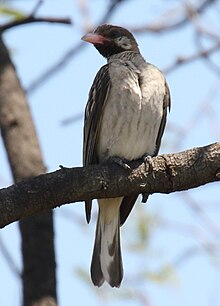Greater honeyguide
| Greater honeyguide | |
|---|---|

| |
| Adult male in Tanzania | |
| Scientific classification | |
| Domain: | Eukaryota |
| Kingdom: | Animalia |
| Phylum: | Chordata |
| Class: | Aves |
| Order: | Piciformes |
| Family: | Indicatoridae |
| Genus: | Indicator |
| Species: | I. indicator
|
| Binomial name | |
| Indicator indicator (Sparrman, 1777)
| |
The greater honeyguide (Indicator indicator) is a
and scientific names refer to its habit of guiding people to bee colonies. Claims that it also guides non-human animals are disputed.The greater honeyguide is a resident breeder in
Description
The greater honeyguide is about 20 cm (7.9 in) long and weighs about 50 g (1.8 oz). Like all African honeyguides, it has bold white patches on the sides of the tail. The male has dark grey-brown upperparts and white underparts, with a black throat. The wings are streaked whitish, and there is a yellow shoulder patch. The bill is pink.
The female is duller and lacks the black throat. Her bill is blackish. Immature birds are very distinctive, having olive-brown upperparts with a white rump and yellow throat and upper breast.

Behaviour and ecology
Diet

The greater honeyguide feeds primarily on the contents of bee colonies ("nests"):
The greater honeyguide is known to guide people to the nests of wild bees.[2][3] A guiding bird attracts a person's attention with wavering, chattering "'tya' notes compounded with peeps or pipes",[4] sounds it also gives in aggression. The guiding bird flies toward an occupied nest (greater honeyguides know the sites of many bees' nests in their territories) and then stops nearby the nest. Honey-hunters then do a final search for the bee colony, and if deemed suitable, harvest honey from the bee colony through the use of fire and smoke to subdue the bees, and axes and machetes to expose the colony. After harvesting the honey, the honeyguide eats wax that is left.[5]
One study found that use of honeyguides by the
In African folklore, it is frequently noted that the honeyguide should be thanked with a gift of honey; if not, it may lead its follower to a lion, bull elephant, or venomous snake as punishment. However, “others maintain that honeycomb spoils the bird, and leave it to find its own bits of comb”.[5] While many depictions of the human-honeyguide mutualism emphasize honey-hunters graciously repaying the birds with piles of wax left in a conspicuous location, such behavior is not universal. The Hadza people of northern Tanzania frequently burn, bury, or hide the wax that lays with the intent of keeping the bird hungry, and more likely to guide again.[3] Some greater honeyguides have stopped this guiding behavior, or mutualism, in parts of Kenya, due to a loss of response from people in the area.[7][8]
Possible guiding of non-human animals
Many sources[9][10][11] say that this species also guides honey badgers. Sparrman noted in the 18th century that indigenous Africans reported this interaction, but Friedmann adds that no biologist has seen it. Friedmann quotes reports that greater honeyguides guide baboons and speculates that the behavior evolved in relation to these species before the appearance of humanity.[12] However, they state,
In addition to that listed by Friedmann (1955:41-47), the only recent record is of a greater honeyguide giving its guiding call to baboons at Wankie Game Reserve, Zimbabwe (C. J. Vernon, pers. comm.). However, Vernon did not see a positive response by the baboons to the honeyguide. No additional records of honeyguides and ratels have been reported since Friedmann (1955) and the first-hand accounts given in his review in support of this association are all of incomplete guiding sequences. No biologist has ever reported this association.
Dean and MacDonald go on to express doubt that honeyguides guide other animals and suggest that the behavior may have evolved with "early man". Later studies estimate that interaction between honeyguides and honey badgers likely occurs, "but is highly localized or extremely difficult to observe, or both".[13] It has also been acknowledged[14] that bee colonies are seasonally very common in Africa and ratels probably have no trouble finding them.
Another argument against guiding of non-human animals is that near cities, where Africans increasingly buy sugar rather than hunting for wild honey, guiding behavior is disappearing. Ultimately, it may disappear everywhere.[5]
Reproduction
In addition to being a
References
- . Retrieved 11 November 2021.
- ^ S2CID 4220280.
- ^ .
- ISBN 978-84-87334-37-5.
- ^ ISBN 978-1-55297-777-4.
- S2CID 206648494. Retrieved 2020-08-14.
- JSTOR 2385968.
- ^ Friedmann, H. (1955). "The Honey-Guides". United States National Museum Bulletin. 208: 50.
- ISBN 978-0-691-01633-7.
- ISBN 978-1-890132-44-6.
- ISBN 978-0-691-01022-9.
- .
- .
- ISBN 978-0-19-854666-5.
- ISSN 1045-2249.
Further reading
- Friedmann, Herbert (1955). The Honey-guides. OCLC 942691.
- Searcy, William A.; Stephen Nowicki (7 December 2023). "Human–Wild Bird Cooperation". S2CID 266055532.
External links
- BBC Radio 4's Natural Histories Honeyguide episode.
- Presenter: Brett Westwood; Experts: Claire Spottiswoode, Brian Wood, Lazaro Hamusikili, Orlando Yassene; Producer: Tim Dee (18 October 2016). "Honeyguide". Natural Histories. BBC. BBC Radio 4.
- Greater honeyguide - Species text in The Atlas of Southern African Birds.
- YouTube Video: Honey Guide Bird(Amazing Partnership) Guiding humans to Beehive
- YouTube Video: BBC Talking to Strangers: honey birds
- Images at ADW


